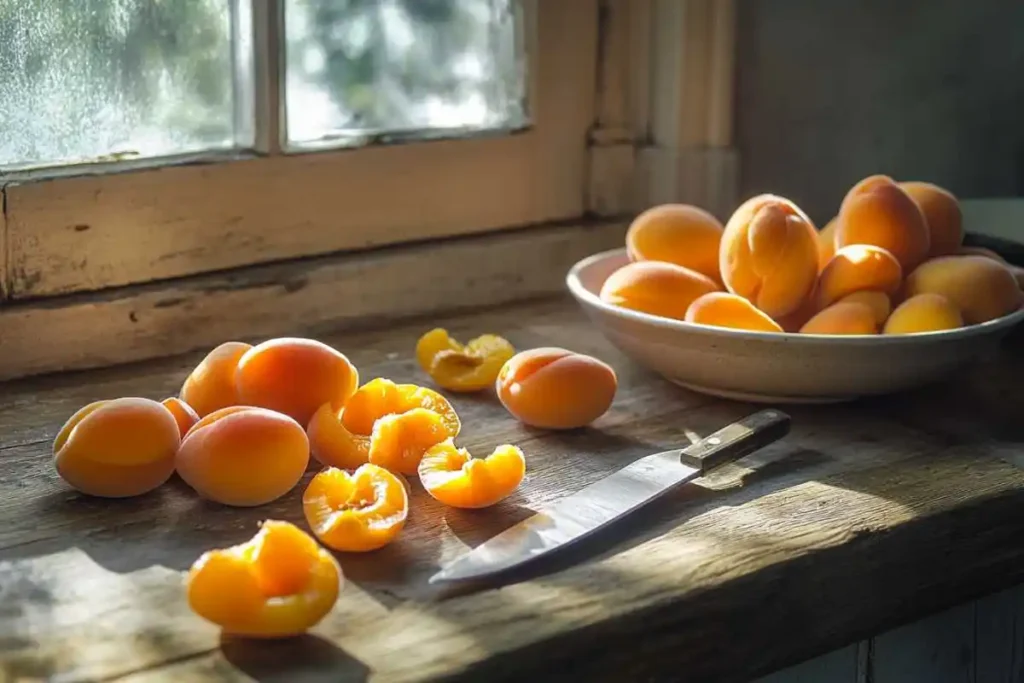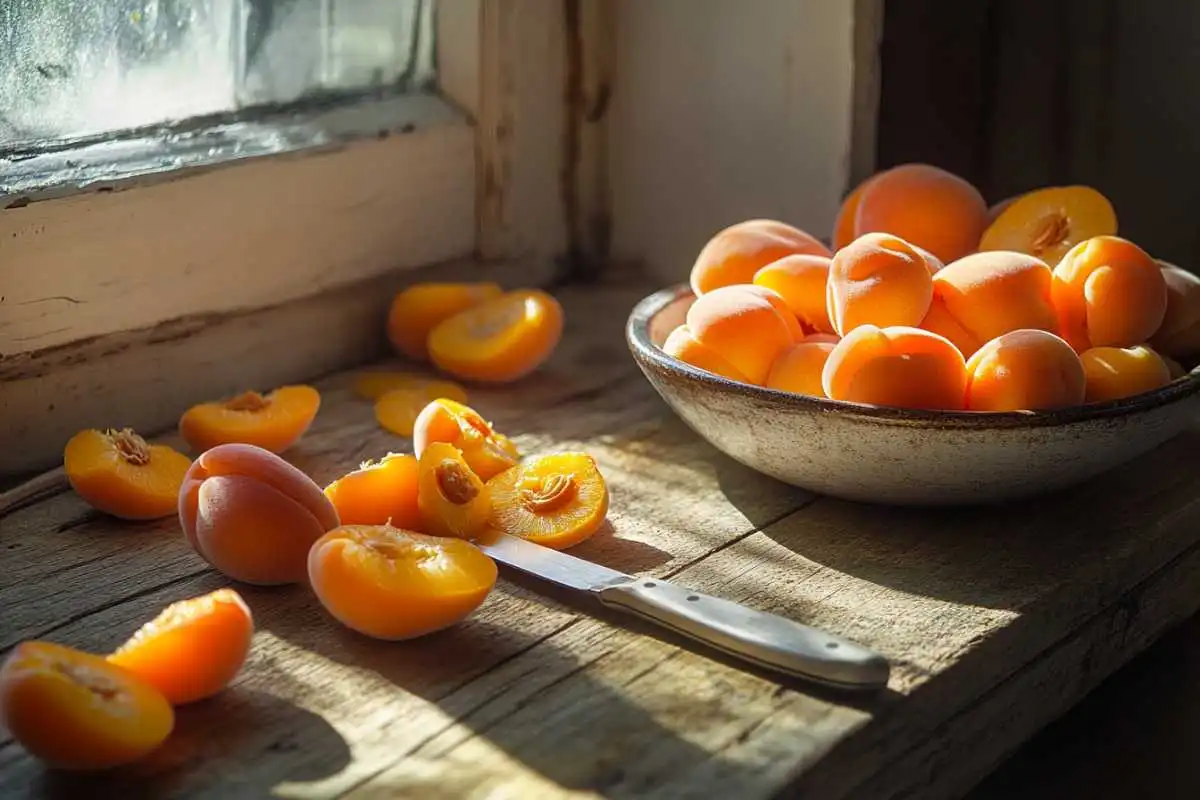When it comes to using apricots in your recipes, one of the first questions you might ask is whether you need to peel them before cooking. The answer isn’t always straightforward—it depends on the type of dish you’re preparing, the method of cooking, and your personal taste preferences. While apricot skin is thin and edible, there are scenarios where peeling can improve both the texture and presentation of your dish.
Why Peeling Apricots Before Cooking May Be Necessary
Why Some Recipes Call for Peeling Apricots
Not all recipes require you to peel apricots, but in some cases, skipping this step can affect the final result. Below are the top reasons why peeling is sometimes essential:
- Improved Texture: In recipes like smooth apricot purees or jams, leaving the skin on can result in an unpleasant texture. If your dish requires a silky-smooth finish, peeling is highly recommended.
- Avoiding Bitterness: Occasionally, the skin of apricots—especially those that are overripe or slightly under-ripe—can have a bitter or tough texture. Removing the skin eliminates this issue.
- Visual Appeal: Recipes like roasted apricots for salads or desserts often look better with the skin removed, as it provides a cleaner, more polished appearance to the dish. For example, if you’re preparing an elegant fruit tart for guests, peeled apricots may create a more appealing presentation.
Methods for Peeling Apricots
If you’ve decided that peeling apricots before cooking is the right step for your recipe, don’t worry—it’s a simple process! Below are two tried-and-true methods:
The Blanching Method
The blanching method is ideal for peeling large batches of apricots quickly and efficiently. Here’s how to do it:
- Prepare Boiling Water and Ice Bath: Bring a pot of water to a boil and fill a separate bowl with cold water and ice.
- Score the Skin: Use a paring knife to gently cut a small “X” at the base of each apricot. This will make peeling easier after blanching.
- Blanch the Apricots: Place the apricots in the boiling water for 30 seconds to one minute.
- Cool in Ice Bath: Transfer the apricots to the ice bath immediately to stop the cooking process.
- Peel the Skin: Once cooled, gently remove the skin using your fingers or a small knife.
The Paring Knife Method
For smaller quantities or firmer apricots, you may prefer the paring knife method. This is a straightforward technique that works well when blanching isn’t practical:
- Gently slice off a thin layer of skin using a sharp paring knife.
- Work carefully around the fruit to avoid cutting away too much flesh.
This method is best used when the apricots are slightly underripe and the skin is tougher to remove.
When You Can Skip Peeling Apricots Before Cooking
While there are cases where peeling is necessary, there are also plenty of scenarios where you can skip this step entirely. Apricot skin is edible, nutrient-rich, and often softens during cooking, making it unnecessary to remove. Below are some examples of dishes where you can leave the skin on:
- Baked or Roasted Dishes: Recipes like roasted apricots for salads or desserts benefit from the caramelization of the skin, which adds flavor and texture.
- Jams and Compotes: If the apricots are being cooked down completely, such as in a jam or compote, the skin usually dissolves into the mixture and doesn’t require removal.
- Savory Dishes: For savory recipes like apricot-glazed chicken or couscous, the skin contributes to the fruit’s overall flavor profile and texture.
Nutritional Benefits of Leaving the Skin On
Leaving the skin on apricots isn’t just a matter of convenience—it also comes with nutritional advantages. The skin is rich in fiber, antioxidants, and vitamins like A and C. By skipping the peeling step, you’re preserving these nutrients while also cutting down on food waste.
Final Thoughts
Whether or not you peel apricots before cooking depends on your recipe and personal preferences. If you’re aiming for a smooth texture or a visually refined dish, peeling is the way to go. However, for rustic dishes or recipes where the skin will soften and integrate into the final dish, peeling isn’t necessary.
Creative Ways to Use Apricots After Peeling Apricots Before Cooking

Once you’ve decided on peeling apricots before cooking for your recipe, it’s time to explore the creative possibilities this versatile fruit offers. Whether you’re preparing a sweet dessert, a savory entrée, or even a refreshing drink, apricots add a unique flavor and texture to any dish.
Below, we’ll look at the best ways to use peeled apricots, explore complementary spices, and uncover techniques to elevate your cooking game.
Transform Peeled Apricots Into Delicious Desserts
Peeled apricots are perfect for desserts where a smooth and silky texture is key. Whether baked, stewed, or blended, the absence of skin ensures a luscious finish. Here are some of the most popular dessert ideas featuring apricots:
- Classic Apricot Pie: A flaky crust filled with peeled apricots coated in sugar, cinnamon, and nutmeg creates a perfect balance of sweet and tangy.
- Apricot Crumble: Peeled apricots baked with a crumbly topping of oats, butter, and brown sugar are ideal for a simple, comforting dessert.
- Apricot Sorbet: Blending peeled apricots with sugar and lemon juice creates a refreshing sorbet, perfect for summer days.
If you’re feeling adventurous, try a salad with roasted apricots for a deliciously tangy dish.
Savory Dishes Made Better with Peeled Apricots
While apricots are often associated with desserts, they shine just as brightly in savory dishes. After peeling apricots before cooking, you can use them to enhance the flavor of meats, grains, or even vegetables.
- Apricot-Glazed Chicken: Peeled apricots cook down into a rich glaze, making this dish perfect for dinner parties or weeknight meals. Pair the glaze with garlic and rosemary for an aromatic finish.
- Couscous with Apricots: Add diced peeled apricots to couscous for a touch of sweetness that balances the dish. Consider pairing it with dried fruits, nuts, and spices like cumin for a Moroccan-inspired flavor.
- Apricot-Chutney Pork Chops: Peeled apricots simmered with onions, ginger, and spices make an irresistible chutney to serve alongside grilled pork chops.
- Combine apricots with bold spices for a unique twist, as seen in our guide to spices that pair best with apricots.
When preparing savory dishes, peeled apricots break down more smoothly and integrate seamlessly into sauces and glazes.
Spice Pairings That Enhance Peeled Apricots
Spices play a crucial role in bringing out the natural flavors of apricots. After peeling apricots before cooking, try experimenting with the following combinations:
- Cinnamon and Nutmeg: Ideal for baked desserts like crumbles and pies, these warm spices complement the sweetness of apricots.
- Ginger: Fresh or powdered ginger adds a spicy kick to chutneys, jams, or marinades.
- Cumin and Coriander: These earthy spices are perfect for savory dishes like couscous or roasted meats with apricot glazes.
- Cardamom: A pinch of cardamom elevates apricot sauces and desserts with a hint of floral complexity.
Unique Ways to Prepare Peeled Apricots
Incorporating peeled apricots into your recipes doesn’t always have to follow traditional cooking methods. Here are some unique ideas to make the most of peeling apricots before cooking:
- Grilled Apricots: Lightly char peeled apricots on the grill for a smoky-sweet addition to salads or as a side for grilled meats.
- Apricot Salsa: Mix peeled apricots with diced tomatoes, red onions, cilantro, and lime juice for a fruity salsa that pairs wonderfully with fish tacos or grilled chicken.
- Apricot Butter: Simmer peeled apricots with sugar and a touch of vanilla until they form a thick, spreadable paste. Use it as a topping for toast, pancakes, or scones.
The Role of Peeled Apricots in Beverages
Apricots aren’t just for solid dishes—they’re also fantastic in drinks! Peeled apricots blend more smoothly into beverages, making them a great addition to:
- Smoothies: Combine peeled apricots with yogurt, honey, and almond milk for a creamy, refreshing drink.
- Cocktails: Muddle peeled apricots with mint and gin for a summer-inspired cocktail.
- Infused Water: Add peeled apricot slices to a pitcher of water along with fresh herbs like basil or thyme for a flavorful, hydrating drink.
Nutritional Benefits of Peeled Apricots
Even after peeling, apricots retain a significant amount of nutrients, making them a healthy addition to your diet. Peeled apricots are rich in:
- Vitamin A: Essential for eye health and skin regeneration.
- Vitamin C: Boosts immunity and helps with collagen production.
- Potassium: Supports heart health and maintains fluid balance in the body.
Although peeling removes the fiber found in the skin, the flesh of the fruit is still packed with essential vitamins and minerals.
Final Thoughts on Peeling Apricots Before Cooking
Peeling apricots can enhance their texture, improve their visual appeal, and unlock new ways to use them in both sweet and savory dishes. From pies and crumbles to glazes and salsas, the possibilities are endless. Pair peeled apricots with complementary spices, try unique preparation methods, and don’t forget to experiment with adding them to beverages for a refreshing twist.
Common Mistakes When Peeling Apricots Before Cooking

Although peeling apricots before cooking is a relatively simple process, there are some common mistakes that can lead to frustration, wasted fruit, or less-than-perfect results. By understanding these pitfalls and how to avoid them, you’ll ensure your apricots are prepped perfectly for any recipe.
Mistake #1: Using Unripe or Overripe Apricots
The ripeness of your apricots plays a huge role in how easily they can be peeled. Unripe apricots are often too firm, making the skin difficult to remove. On the other hand, overripe apricots can be mushy, leading to fruit that falls apart during peeling.
- How to Fix It: Choose apricots that are firm but slightly soft to the touch. A ripe apricot will yield gently when pressed but still hold its shape.
Mistake #2: Skipping the Blanching Step
One of the most effective techniques for peeling apricots before cooking is blanching. Skipping this step can result in wasted time and fruit, as the skin is much harder to remove without it.
- How to Fix It: Always blanch your apricots when preparing large quantities. Boiling them briefly and shocking them in an ice bath loosens the skin, making peeling quick and efficient. If you’re worried about losing the fruit’s vibrant color during blanching, add a squeeze of lemon juice to the boiling water to preserve it.
Mistake #3: Throwing Away the Skins
Many people toss the apricot skins without realizing they can be repurposed. While peeling apricots is sometimes necessary for texture or aesthetics, the skins still contain valuable nutrients and flavor.
- How to Fix It: Instead of discarding the skins, save them for other uses. Apricot skins can be dried and blended into a powder to add to smoothies, baked goods, or even salad dressings. Alternatively, simmer the skins with water and sugar to create a syrup for cocktails or desserts.
Why Peeling Apricots Before Cooking Matters for Certain Recipes

There are specific dishes where the choice to peel or not peel can make or break the final result. Understanding these situations can help you avoid ruining a recipe and ensure you get the best flavor and texture possible.
Smooth Sauces and Purees
When making recipes like apricot puree, jam, or baby food, peeling is essential. The skin doesn’t blend as smoothly as the flesh, leaving tiny bits that can disrupt the creamy consistency of your dish. For example, a classic apricot coulis for desserts demands a silky-smooth finish, which is only achievable with peeled fruit.
Roasted and Grilled Apricots
For recipes where caramelization plays a role, such as roasted or grilled apricots, peeling is a matter of personal preference. Leaving the skin on can add texture and hold the fruit together, but it may also become tough or chewy after roasting. Peeled apricots, on the other hand, develop a softer texture and absorb marinades or spices more effectively.
Tools That Make Peeling Apricots Before Cooking Easier
Using the right tools can make all the difference when peeling apricots. Here are some must-haves for making the process quick and efficient:
- Paring Knife: A small, sharp paring knife is ideal for scoring the skin before blanching and for peeling small amounts of fruit.
- Slotted Spoon: Essential for transferring apricots from boiling water to an ice bath without damaging the delicate fruit.
- Peeler with Serrated Blades: If you prefer not to blanch, a serrated peeler can help grip the slippery skin and remove it cleanly.
Maximizing Flavor After Peeling Apricots Before Cooking
Once your apricots are peeled, it’s time to focus on bringing out their natural flavors. Here are a few tips for making peeled apricots shine in your recipes:
- Marinate with Citrus and Honey: Toss peeled apricots with lemon juice, orange zest, and a drizzle of honey to enhance their natural sweetness. This works beautifully for desserts or as a topping for yogurt.
- Spice Them Up: Sprinkle peeled apricots with cinnamon, nutmeg, or cardamom before baking or roasting to add a warm, fragrant flavor.
- Combine with Savory Ingredients: Pair peeled apricots with ingredients like goat cheese, fresh herbs, or balsamic glaze for a sophisticated flavor contrast in salads or appetizers.
Final Thoughts on Avoiding Mistakes
Peeling apricots before cooking doesn’t have to be a complicated or frustrating process. By selecting the right fruit, using proper techniques like blanching, and repurposing the skins, you can make the most of every apricot.
With these tips in mind, your peeled apricots will be ready to elevate both sweet and savory recipes. Whether you’re preparing an apricot tart, glaze, or salad, you can feel confident knowing you’ve avoided the common pitfalls and maximized their flavor potential.
For more inspiration and tips, explore our guides to smooth tomato sauces or creative uses for pasta.

